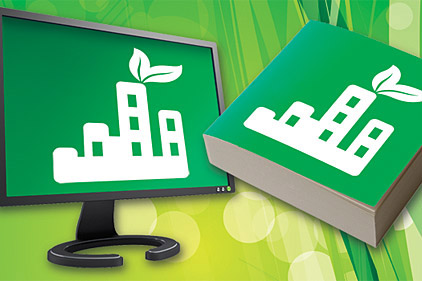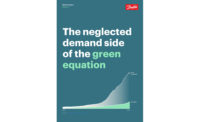Just as there’s no widely accepted definition of what, say, a commissioning agent’s range of duties entail, there’s no single process for making your health care facility more sustainable. It depends on current circumstances, leadership and personnel, organizational priorities, and certainly, budget. And similarly, when we deliver an article about web resources for assisting you in your sustainability efforts, you can expect to find some overlap in broad themes and areas to tackle.

|
Don’t let that stop you, though. The important thing is that facilities are getting engaged one way or another, regardless of which paths they’re using to reach the battleground for improved energy efficiency. We’re skipping LEED®here since it is so ubiquitous, but otherwise, you’ll find sites and dozens of free tools/documents covering many angles of this challenge, courtesy of hosts ranging from federal initiatives to local groups to associations.
For your convenience, we’re replacing some unwieldy web addresses with custom URL’s. They look like they’re our webpages, but they will take you to the right websites.
(NOTE: This month, we’ll devote a different Facebook update to each of these websites for your convenience. “Like” the magazine on Facebook and we’ll bring these to you in a more click-friendly environment to help you surf, sample, and succeed.)
ENERGY STAR®
Everyone is familiar with this EPA performance-based metric. Its website’s primary health care page (www.esmagazine.com/hcEnergyStar) opens with a sustainability statistic designed to focus your attention right away:
“Every dollar a nonprofit healthcare organization saves on energy has the equivalent impact on the operating margin as increasing revenues by $20 for hospitals or $10 for medical offices.”1
From there, we get to a laundry list of potential topics and resources, including but not limited to:
• Energy management in senior care communities
•
Making the business case for good energy management in health care facilities
• Health care energy savings financial analysis calculators
• Health care benchmarking starter kit
• Recommended workshops for health care
• Target Finder for hospital additions
• Section on on-site renewable energy
(Speaking of on-site renewable energy, you can find a page devoted to a single question, “Is your facility a good candidate for CHP?” at www.esmagazine.com/hcCHP. The EPA contact for this issue is listed as Gary McNeil, mcneil.gary@epa.gov.)
Energy Star®dedicates a separate page to energy management in senior care facilities (www.esmagazine.com/hcseniorcare). Links and PDFs on this page include help classifying and benchmarking your facility within the Portfolio Manager, and also some recording training on fostering a conservation approach among employees and residents. You can apply for national recognition for the facility’s progress from that page as well, and members can participate in monthly web networking conferences about best practices for member organizations.
METROPOLITAN CHICAGO HEALTHCARE COUNCIL
Of course, you can also avail yourself of more general Energy Star resources on that site, but a few external links might be of use, including the energy best practices list from the Metropolitan Chicago Healthcare Council (www.esmagazine.com/hcChicago).
That list comprises over 30 bullet points in broader categories including operations, maintenance, upgrades, strategies and long-term planning, and unique projects or upgrades. Everything on that list is on target for our readership, from groundwater cooling to thermostat calibration, culled from a nationwide best practices survey conducted by Sieben Energy Associates a few years ago.
DEPARTMENT OF VETERANS AFFAIRS
The Department of Veterans Affairs obviously deals with health care on an ongoing basis in a number of settings, and while we’ll only mention one document from them for this article, it happens to probably be the most thorough document mentioned, too.
Dated 2008, the concisely titled HVAC Design Manualis written specifically for the following range of applications:
• New hospitals
• Replacement hospitals
• Ambulatory care
• Clinical additions
• Energy centers
• Outpatient clinics
• Animal research facilities
• Laboratory buildings
Find this document in its entirety at www.esmagazine.com/hcVA.
If the Veterans Affairs document is the most comprehensive single document for design here, then www.sustainabilityroadmap.org may be the most comprehensive website here in providing, as their tagline states, “a guide for achieving your sustainability goals.” And to be clear, while the web address sounds general, the site itself is focused specifically on hospitals.
Contents range from managing water and chemicals to the hospital’s supply chain in general; you could spend a long time inside the site. But within an energy focus, visitors get a thoughtful overview combining big-picture benefits with links and some hard statistics. Further inside the Energy area, sections to choose from include the following.
• Information on drivers and barriers to sustainability efforts
• Strategies for building sustainability teams
• Steps for creating an energy management plan
• Strategies for financing sustainability projects
• Performance improvement measures (projects or activities to improve energy use
• Green Light projects — low-cost measures for meaningful results
Furthermore, as the site mentions, many of the interior pages will also include case study references and further tools or tips for implementing specific measures.
HOSPITALSUSTAINABILITY.ORG
Now there’s a URL you might’ve guessed yourself, huh? This looks like an outgrowth of the American Hospital Association. The site covers the full range of sustainability topics, so some of them are beyond our usual scope here, but in the Energy & Emissions section, they have a decent bullet list of the relevant areas including:
• Commissioning
• Energy efficiency
• Ozone protection
• System-level energy metering
• Renewable energy
• Emissions reduction reporting
• Transportation
The real reason to mention this site, though, is the downloadable Leadership Checklist.
Real institutional progress requires buy-in at the top of the organizational chart, and this one-pager is a simple tool for a management team to see where things stand currently and then track some progress along the way. It’s an accessible, simple nine-item sheet that could crystallize and fuel improvements throughout the facility in a more cohesive manner.
U.S. DEPARTMENT OF ENERGY
The DOE has its own substantial site, as you’d expect, but we’ll draw your attention to a two-page brochure PDF titled, “EnergySmart Hospitals: Retrofitting Existing Facilities” (www.esmagazine.com/hcDOE). Geared toward facility managers and operators, the content hits on a good number of smaller- to medium-sized activities for reducing energy expenses.
The tips themselves are too many to mention here, but the general categories are:
• Lighting
• HVAC
• Building envelope
• Plug loads / water efficiency
• Creating an energy management program
That last category includes a circular eight-piece graphic that gets the idea across succinctly. All in all, this one could bring a lot of value per page for such a brief publication, especially for facilities that consider themselves as “just getting started” on such efforts.
GREEN GUIDE FOR HEALTH CARE
Another possible resource is the Green Guide v2.2 Design And Construction, which has a little age on it at this point (dated 2007), but which looks at seven “credit groups” — Integrated Design & Operation, Sustainable Sites, Energy and Atmosphere, Water, Materials & Resources, Indoor Environmental Quality, and Innovation in Design.
Find guidance for each of those groups along with related health information in that down-loadable (and 254-page) document, available at http://www.gghc.org/.
HEALTH CARE WITHOUT HARM
This effort/website was new to us and it has issued its own Green Guide For Health Care, including a revised operations section (2008) that you can fetch separately. Other resources on this site include a few tools and documents worth mentioning.
• Energy impact calculator
• Displacement ventilation research summary report (PDF)
• Health care ventilation research collaborative (2010)
• EPRI report: Background, trends, issues, and opportunities in health care (PDF)
• EPRI report: Energy market profiles: Hospital buildings, equipment, and energy use
That last item does require log-in. Check it all out at www.esmagazine.com/hcGG.
LAST BUT NOT LEAST
The American Society for Healthcare Engineering (ASHE) provides a slew of resources, ranging from papers to other training documents. That said one of the most unique is an ar-chive they call the Post-Conference Live Learning Center (http://www.softconference.com/ashe/).
Unlike almost everything mentioned in this article, this resource is not free. However, the page lists the costs as $299 for non-attendees and $229 for attendees. You can review the full list of seminars and sessions from the three-day 2011 conference at www.esmagazine.com/hcASHE, and it appears you can purchase access to just one day’s content if you’d like. Content includes not only the handouts given to attendees but also audio recordings synchronized to each session’s PowerPoint slides. Given the wide range of topics addressed, that may not be a bad option for the professionally curious but travel-constrained.ES
1. This assumes a 5% and 10% operating margin respectively. To calculate this metric based on your operating margin, go to the Financial Equivalency Calculator in the ENERGY STAR Healthcare Energy Savings Financial Analysis Calculators.







